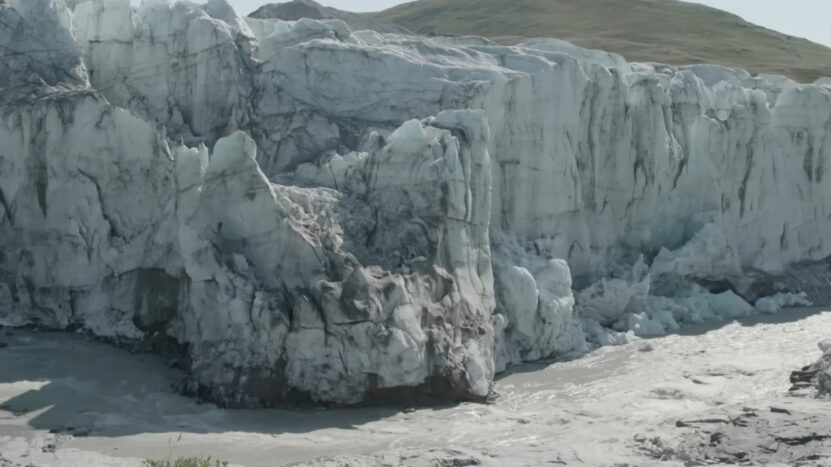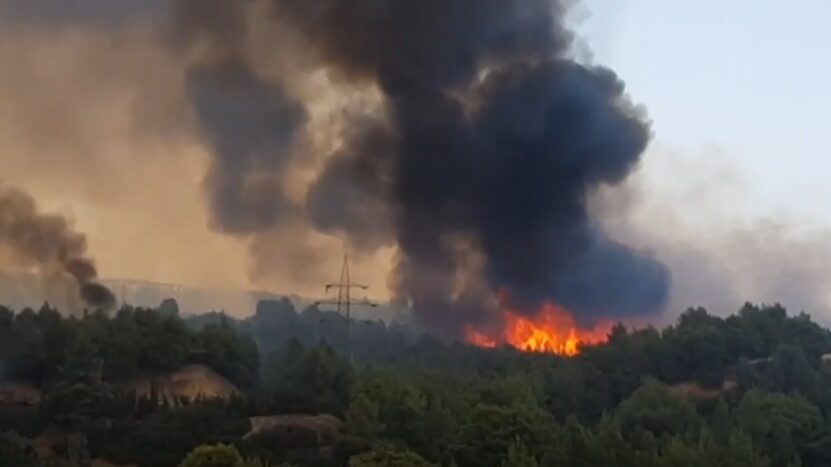Reports have identified the top four most severe risks over the next decade as extreme weather events, critical changes to Earth systems, biodiversity loss and ecosystem collapse, and natural resource shortages.
The report emphasizes that cooperation on urgent global issues may be lacking, highlighting the need for concerted action and collaboration to address climate and nature emergencies.
Kirsten Schuijt, Director General of WWF International, stated:
“The interlinked crises of climate change and biodiversity loss are among the most severe risks the world faces and cannot be tackled in isolation. We’ve just experienced the hottest year on record, with devastating heatwaves, floods, and storms affecting lives and livelihoods. Without urgent action, these threats will intensify, pushing us closer to causing irreversible damage to society and ecosystems.”
Risks About Climate, Biodiversity, and Wildlife
Species Extinction
New report – global vertebrate populations (mammals, birds, reptiles, amphibians, fish) declined 60% from 1970-2014 https://t.co/Ptc5sldXGU
— WWF News (@WWFnews) October 30, 2018
One of the most severe impacts of climate change is the rate of extinction.
From 1970 to 2014, the average size of vertebrate populations decreased by 60% according to WWF report.
Impact on Species Ranges
Climate change also forces species to adapt rapidly to changing conditions.
As temperatures rise by 1.5C to 2C, terrestrial species face significant range reductions.
These shifts can adversely impact local species, increase turnover, and elevate the risk of global extinctions.
By the mid-21st century, as many as 30-50% of the species currently inhabiting the Earth may no longer exist.
Extreme weather patterns, exacerbated by climate change, further threaten biodiversity and wildlife.
During the end of 2019 and the beginning of 2020, fires in Australia, intensified by climatic factors, destroyed approximately 97 square kilometers of forests and habitats.
Each year, over 12 million hectares of land are lost to desertification, land degradation, and drought.
This loss equates to the total arable land in Germany. These processes not only displace species but also reduce the available habitat for future generations.
Human activity has profoundly changed at least three-quarters of terrestrial habitats and more than 66% of marine environments.
The decline in habitats has brought species like the guacamayas to the brink of extinction.
This transformation continues to escalate, with significant repercussions for biodiversity and ecosystem services.
The IPBES Global Assessment Report on Biodiversity and Ecosystem Services elaborates on these extensive alterations.
Impact on Oceans

Oceans and other bodies of water are severely affected by climate change, facing issues such as warming temperatures, acidification, and coral bleaching. The top layers of the ocean, particularly the upper 100 meters, have experienced significant warming.
Since 1969, these layers have warmed by more than 0.6 degrees Fahrenheit according to EPA.GOV. This is largely because the ocean has absorbed approximately 90% of the excess heat generated by rising greenhouse gas emissions.
Global sea levels have also been rising at an alarming rate. Over the last century, sea levels have increased by about 8 inches (20 centimeters). In the past two decades alone, the rate of sea-level rise has nearly doubled compared to the previous century.
This acceleration is alarming, reaching new record highs. Between 2013 and 2021, the average sea-level rise has been approximately 4.5 millimeters per year.
Ocean acidity is another significant impact of climate change. Since the industrial revolution began, ocean acidity has increased by roughly 30%.
Oceans have absorbed between 20% and 30% of human-made carbon dioxide emissions, which equates to about 7.2 to 10.8 billion metric tons each year as per NOAA report. This increase in carbon dioxide absorption has had a profound effect on marine ecosystems.
Coral reefs are especially vulnerable. With global temperatures projected to rise, coral reefs could dwindle dramatically.
At 1.5 degrees of warming, coral cover may decline to 10-30% of their previous levels. A 2-degree increase could reduce coral coverage to less than 1%.
For example, the Great Barrier Reef has lost half of its corals since the 1990s due to sustained ocean temperature rises that have led to extensive coral bleaching. This has greatly affected the marine life that relies on the reef for habitation.
Impact on Ice and Glaciers

Rising global temperatures significantly affect ice patterns, with notable reductions in ice mass observed worldwide.
Recent data shows Greenland losing an average of 279 billion tons of ice annually from 1993 to 2019. Similarly, Antarctica has been losing about 148 billion tons per year during the same period. This ice loss is roughly equivalent in weight to the entire mass of Mount Everest.
According to The World Counts, approximately 750 billion tons of ice melt each year due to global warming. This translates to 24,000 tons of water adding to the global oceans every second.
The World Meteorological Organization highlights that Arctic air temperatures have increased at more than twice the global rate since the mid-1980s. This extensive warming trend has contributed to the reduction in sea ice, the Greenland ice sheet, and mountain glaciers, along with rising permafrost temperatures.
Weather Patterns
Data from multiple studies into “extreme event attribution” indicate that human-caused climate change has made 68% of extreme weather events in the past 20 years more likely or severe as per NCBI.
Stats from the Royal Meteorological Society highlight that 2020 was one of the wettest years in the UK since 1862, recording 116% of the 1981-2010 average rainfall. This trend of rising temperatures and unpredictable weather does not spare other regions either.
For instance, Greater London and surrounding counties experienced significant increases in rainfall during the summer of 2021.
Heatwaves
Heatwaves are becoming more frequent and intense across the globe. The UK saw its first-ever amber heat warning issued by the Met Office in July 2021.
The highest temperature recorded in Northern Ireland hit 31.3°C on 21 July 2021, setting an all-time high.
Moreover, from 2020 onwards, record temperatures have been recorded in numerous countries worldwide, including Belarus, Belgium, and Japan. Continuation of this trend into 2021 and projections for 2024 underscore the severity of the situation.
Mortality and Health
Heat-related mortality is climbing, particularly among vulnerable populations. The Lancet reports a 53.7% increase in heat-related deaths among individuals older than 65 over the past two decades. As global temperatures continue to rise, these figures are expected to grow.
| Region | Temperature Record |
|---|---|
| Northern Ireland | 31.3°C |
| Greater London | 48% more rainfall |
| West Sussex | 52% more rainfall |
Wildfires

Global warming also exacerbates wildfires, which are devastating vast regions. For instance, the UN reports that wildfires have destroyed roughly 30 million acres from 2018 to 2020. These fires are burning longer and spreading further than ever before, illustrating another dire consequence of shifting weather patterns.
Food Insecurity
Extreme weather events also contribute significantly to food insecurity. The World Food Programme reports that in 2020, at least 155 million people encountered acute food insecurity due to extreme weather, conflicts, and economic disturbances.
Future Climate Change Projections
Several reliable organizations provide projections on climate change, detailing both the current scenario and future expectations.
According to the IPCC, there is a significant gap between necessary carbon dioxide reductions and current trends. Specifically, to maintain global warming below 2°C, there should be a reduction of 12-15 gigatons of CO2-equivalent.
For the more ambitious 1.5°C target, the gap expands to 29-32 gigatons, which is comparable to the combined emissions of the six largest global emitters.
Moreover, the need to curb fossil fuel production is evident.
To stay within the 1.5°C limit, a yearly reduction of approximately 6% in fossil fuel output is required between 2020 and 2030. Contrarily, current national projections indicate an average annual increase of 2%. If this trend continues, fossil fuel production by 2030 could surpass what is consistent with maintaining the 1.5°C limit, effectively doubling it.
Projections also indicate that the areas on Earth experiencing extremely high temperatures could expand substantially. Currently, only 0.8% of the Earth’s land has mean annual temperatures above 29°C.

This is mostly situated in regions like the Sahara desert and Saudi Arabia according to earth.org. However, under a high emissions scenario, by 2070, these extreme temperatures could extend to cover regions inhabited by up to three billion people. This expansion would render many new areas uninhabitable because of the heat by the century’s end.
In terms of plastic production and its environmental impact, the forecast shows a bleak increase. The Heinrich Böll Foundation warns that plastic production and use are expected to double within the next two decades and quadruple by early 2050s.
This surge poses a significant problem, as plastics contribute to greenhouse gases such as CO2 and methane throughout their lifecycle—from production to consumption—adversely affecting the environment.
Finally, the economic impact of climate change is staggering. Based on current trends, climate change might cost the global economy 11-14% of the global gross domestic product (GDP) by mid-century as NY Times predicts it. With a high emissions scenario, this cost could escalate to 18%, while efforts to keep warming below 2°C could limit the damage to approximately 4%.
In light of these projections, it becomes clear that immediate action is necessary across various fronts to mitigate the dire consequences anticipated for the future.
Climate Finance

The increasing focus on eco-investing, the scrutiny on environmental, social, and governance (ESG) practices, and the demand for transparency in investment highlight the enduring relevance of climate finance. The discussion spans governmental, organizational, and individual perspectives.
In 2018, developed nations committed to providing $100 billion annually to developing countries to address climate impacts. However, actual contributions have fallen short, with only $78.9 billion met. This gap demonstrates the continual challenge in meeting climate finance goals.
Global Fossil Fuel Subsidies
- Fossil fuel subsidies total $345 billion annually, leading to broader costs of $5 trillion, including environmental degradation.
- Redirecting these subsidies could significantly bolster sustainable initiatives.
Investment Benefits

Early warning systems for natural disasters, for instance, yield substantial returns. The World Bank notes these systems can generate benefits up to 10 times their initial cost through preserved lives and property.
Sector-Specific Adaptations
A study by the Global Commission on Adaptation suggests that investing $1.8 trillion in early warning systems, climate-resilient infrastructure, dryland agriculture, mangrove protection, and resilient water resources could yield $7.1 trillion in avoided damages and social benefits. Despite these potential returns, adoption varies:
- Only 38% of small enterprises have invested in climate risk adaptation.
- In contrast, 60% of large firms have made similar investments.

